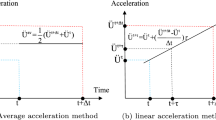Abstract
This paper presents a step-by-step time integration algorithm for efficiently solving second-order nonlinear dynamic problems. The method employs the rewriting of motion as two sets of first-order differential equations. The interpolation of the relevant quantities is achieved by a particular quadratic polinomial expression for the velocities and forces and is defined by values at the boundaries of the time step. Then the time definite integrals of both first-order ordinary differential equations define the numerical relations in the step. An accurate extrapolation predictor and an adaptive time stepping procedure are used as the time predictor–corrector method.
























Similar content being viewed by others
References
Belytschko, T., Hughes, T.: Computational Methods for Transient Analysis. North Holland, Amsterdam (1983)
Hughes, T.: The Finite Element Method. Prentice Hall, New Jersey (1987)
Géradin, M., Rixen, D.: Mechanical Vibrations Theory and Applications to Structural Dynamics. Wiley, Paris (1994)
Bathe, K.J.: Finite Element Procedures. Prentice Hall, New Jersey (1996)
Hulbert, G., Chung, J.: Explicit time integration algorithms for structural dynamics with optimal numerical dissipation. Comput. Methods Appl. Mech. Eng. 137, 175–188 (1996)
Géradin, M., Cardona, A.: Flexible Multibody Dynamics. A Finite Element Approach. Wiley, New Jersey (2000)
Newmark, N.: A method of computation for structural dynamics. J. Eng. Mech. Div. ASCE 85, 67–94 (1959)
Belytschko, T., Schoeberle, D.F.: On the unconditional stability of an implicit algorithm for nonlinear structuraldynamics. J. Appl. Mech. 42, 865–869 (1975)
Hughes, T.J.R., Caughy, T.K., Liu, W.K.: Finite-element methods for nonlinear elastodynamics which conserve energy. J. Appl. Mech. 45, 366–370 (1978)
Simo, J.C., Tarnow, N.: A new energy and momentum conserving algorithm for the nonlinear dynamics of shells. Intern. J. Numer. Methods Eng. 37, 2527–2549 (1994)
Armero, F., Petöcz, E.: Formulation and analysis of conserving algorithms for frictionless dynamic contact/impact problems. Comput. Methods Appl. Mech. Eng. 158, 269–300 (1998)
Kuhl, D., Ramm, E.: Generalized energy-momentum method for non-linear adaptive shell dynamics. Comput. Methods Appl. Mech. Eng. 178, 343–366 (1999)
Hoff, C., Pahl, P.J.: Development of an implicit method with numerical dissipation for generalized single step algorithm for structural dynamics. Comput. Methods Appl. Mech. Eng. 67, 367–385 (1988)
Chung, J., Hulbert, G.M.: A time integration algorithm for structural dynamics with improved numerical dissipation: the generalized-\(\alpha \) method. J. Appl. Mech. 60, 371–375 (1993)
Betsch, P., Steinmann, P.: Conservation properties of a time FE method. part I: time-stepping schemes for N-body problems. Int. J. Numer. Methods Eng. 49, 599–638 (2000)
Pimenta, P.M., Campello, E.M.B., Wriggers, P.: An exact conserving algorithm for nonlinear dynamisc with rotational DOFs and general hyperelasticity. part 1 rods. Comput. Mech. 42, 715–732 (2008)
Argyris, J., Papadrakakis, M., Mauroutis, Z.S.: Nonlinear dynamic analysis of shells with the triangular element TRIC. Comput. Methods Appl. Mech. Eng. 192, 3005–3038 (2003)
Lopez, S.: Changing the representation and improving stability in time-stepping analysis of structural non-linear dynamics. Nonlinear Dyn. 46, 337–348 (2006)
Lopez, S.: Improving stability by change of representation in time-stepping analysis of non-linear beams dynamics. Intern. J. Numer. Methods Eng. 69, 822–836 (2007)
Lopez, S.: Relaxed representations and improving stability in time-stepping analysis of three-dimensional structural nonlinear dynamics. Nonlinear Dyn. 69, 705–720 (2012)
Hughes, T.: The Finite Element Method: Linear Static and Dynamic Finite Element Analysis. Courier Dover Publications, New York (2012)
Bathe, K.J., Baig, M.M.I.: On a composite implicit time integration procedure for nonlinear dynamics. Comput. Struct. 83, 2513–34 (2005)
Bathe, K.J.: Conserving energy and momentum in nonlinear dynamics: a simple implicit time integration scheme. Comput. Struct. 85, 437–45 (2007)
Bathe, K.J., Noh, G.: Insight into an implicit time integration scheme for structural dynamics. Comput. Struct. 98, 1–6 (2012)
Simo, J.C., Wong, K.K.: Unconditionally stable algorithms for rigid body dynamics that exactly preserve energy and momentum. Intern. J. Numer. Methods Eng. 31, 19–52 (1991)
Gonzalez, O.: Exact energy and momentum conserving algorithms for general models in non-linear elasticity. Comput. Methods Appl. Mech. Eng. 190, 1763–1783 (2000)
Lens, E.V., Cardona, A., Geradin, M.: Energy preserving time integration for constrained multibody systems. Multibody Syst. Dyn. 11, 41–61 (2004)
Krenk, S.: State-space time integration with energy control and 4th order accuracy for linear dynamic systems. Intern. J. Numer. Methods Eng. 65, 595–619 (2006)
Malakiyeh, M.M., Shojaee, S., Bathe, K.J.: The Bathe time integration method revisited for prescribing desired numerical dissipation. Comput. Struct. 212, 289–298 (2019)
Noh, G., Bathe, K.J.: The Bathe time integration method with controllable spectral radius: The \(\rho _{\infty }\)-Bathe method. Comput. Struct. 212, 299–310 (2019)
Humar, J.L.: Dynamics of Structures. CRC Press, Leiden (2012)
Arnold, V.I.: Mathematical Methods of Classical Mechanics. Prentice-Hall, Englewood Cliffs (1989)
Ogden, R.W.: Non-Linear Elastic Deformations. E. Horwood, Chichester (2013)
Kuhl, D., Ramm, E.: Constraint energy momentum algorithm and its application to non-linear dynamics of shells. Comput. Methods Appl. Mech. Eng. 136, 293–315 (1996)
Crisfield, M.A.: Non-linear Finite Element Analysis of Solids and Structures. Advanced Topics, vol. 2. Wiley, Chichester (2003)
Nour-Omid, B., Rankin, C.C.: Finite rotation analysis and consistent linearization using projectors. Comput. Methods Appl. Mech. Eng. 93, 353–384 (1991)
Pacoste, C.: Co-rotational flat facet triangular elements for shell instability analyses. Comput. Methods Appl. Mech. Eng. 156, 75–110 (1998)
Lopez, S.: Three-dimensional finite rotations treatment based on a minimal set parameterization and vector space operations in beam elements. Comput. Mech. 52, 377–399 (2013)
Author information
Authors and Affiliations
Corresponding author
Ethics declarations
Conflict of interest
The authors declare that they have no conflict of interest.
Additional information
Publisher's Note
Springer Nature remains neutral with regard to jurisdictional claims in published maps and institutional affiliations.
Rights and permissions
About this article
Cite this article
Lopez, S. A predictor–corrector time integration algorithm for dynamic analysis of nonlinear systems. Nonlinear Dyn 101, 1365–1381 (2020). https://doi.org/10.1007/s11071-020-05798-x
Received:
Accepted:
Published:
Issue Date:
DOI: https://doi.org/10.1007/s11071-020-05798-x




